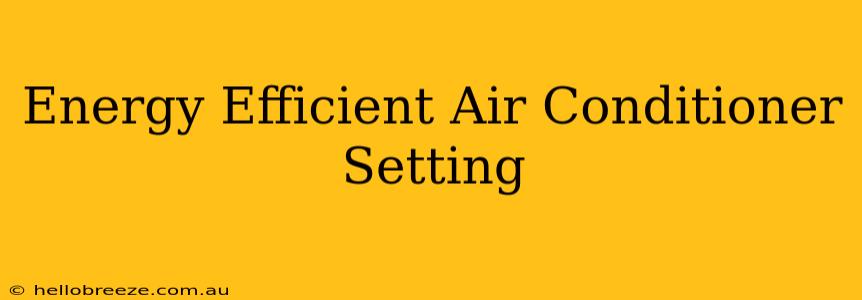Summer's heat can be brutal, but your air conditioner doesn't have to break the bank. Learning how to set your AC for maximum energy efficiency can significantly reduce your energy bills without sacrificing comfort. This guide will walk you through the optimal settings and smart strategies to keep your cool while keeping your wallet happy.
Understanding Your Air Conditioner's Settings
Before diving into energy-saving techniques, it's crucial to understand the different settings on your air conditioner. Most units have:
- Temperature Setting: This controls the desired temperature inside your home.
- Fan Speed: Options usually include Auto, Low, Medium, and High.
- Mode: Common modes include Cool, Fan Only, and Heat. Some units also offer "Energy Saver" or "Eco" modes.
Setting Your AC for Maximum Energy Efficiency
Here's how to optimize your AC settings for energy savings:
1. Raise the Thermostat Temperature:
This is the single most impactful change you can make. For every degree you raise the thermostat, you can save around 3% on your cooling costs. Aim for a temperature that's comfortable but not excessively cold. Consider setting it a few degrees higher when you're away from home or asleep. A programmable or smart thermostat can automate this process.
2. Utilize the Fan Setting Wisely:
While the temptation is to always use "High," "Auto" is often the most energy-efficient setting. In "Auto" mode, the fan only runs when the compressor is actively cooling, reducing unnecessary energy consumption. Using "Low" or "Medium" can be a compromise between energy savings and quicker cooling, especially in smaller rooms.
3. Leverage Programmable or Smart Thermostats:
These advanced thermostats allow you to schedule temperature adjustments throughout the day, automatically lowering the temperature when you're home and raising it when you're away. Many offer energy-saving features and even learning capabilities to adapt to your usage patterns, further optimizing energy consumption.
4. Regular Maintenance is Key:
A well-maintained AC unit operates more efficiently. Regularly changing air filters, cleaning coils, and scheduling professional maintenance can drastically improve your system's performance and prolong its lifespan. A dirty filter can restrict airflow, forcing your AC to work harder and consume more energy.
5. Optimize Your Home's Insulation:
Improving your home's insulation can significantly reduce the workload on your air conditioner. Proper insulation helps keep cool air inside and hot air outside, reducing the energy needed to maintain a comfortable indoor temperature.
6. Utilize Other Cooling Strategies:
Consider employing other cooling methods to reduce the strain on your AC. Open windows during cooler evening hours to let in a breeze, use fans strategically to circulate air, and keep blinds and curtains closed during the sunniest parts of the day to block solar heat gain.
Beyond Settings: Further Energy Efficiency Tips
- Seal air leaks: Caulk and weatherstrip windows and doors to prevent cool air from escaping.
- Use energy-efficient appliances: Opt for appliances with high energy-efficiency ratings (Energy Star certified products).
- Plant trees: Strategically planted trees can provide shade and reduce solar heat gain on your home.
By implementing these energy-efficient air conditioner settings and strategies, you can enjoy a comfortable and cool home without significantly impacting your energy bills. Remember, even small changes can add up to substantial savings over time. Start implementing these tips today and experience the difference!

